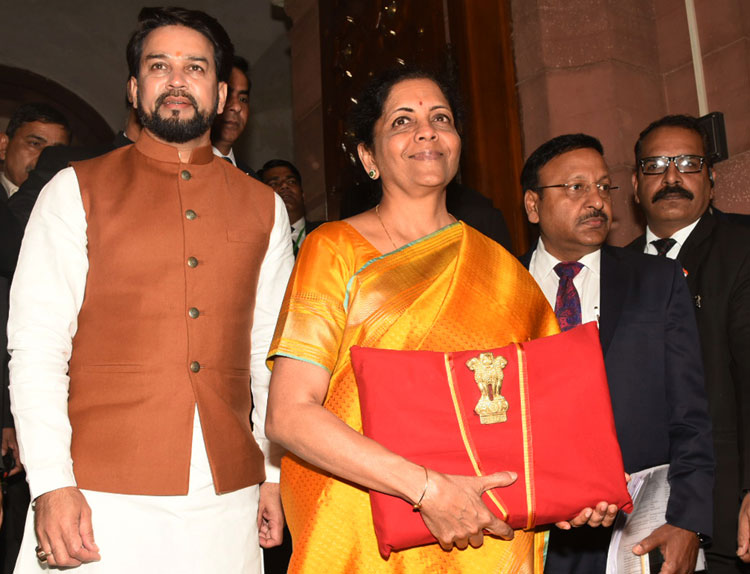INDIAN ARMED FORCES CHIEFS ON
OUR RELENTLESS AND FOCUSED PUBLISHING EFFORTS

SP Guide Publications puts forth a well compiled articulation of issues, pursuits and accomplishments of the Indian Army, over the years

I am confident that SP Guide Publications would continue to inform, inspire and influence.

My compliments to SP Guide Publications for informative and credible reportage on contemporary aerospace issues over the past six decades.
- Interim Defence Budget 2024-25 — An Analysis
- Union Defence budget 2024
- Indian Army: In quest of greater firepower and policy recommendations for gaps
- Indian Army Annual Press Conference 2024
- 6G will transform military-industrial applications
- Tata Boeing Aerospace Delivers 250 AH-64 Apache Fuselages, Manufactured in India
Defence Budget 2021-2022
 |
The Author is Former Director General of Information Systems and A Special Forces Veteran, Indian Army |

Finance Minister Nirmala Sitharaman is scheduled to present the Union Budget for FY2021-2022 on February 1. There are varied suggestions and expectations. Minhaz Merchant writes, “When Prime Minister Narendra Modi took office in May 2014, he vowed to end the red tape that for decades had choked Indian business. More than six years later, on the eve of the 2021-22 Union Budget, it’s time to take stock.” Is he hinting at very little progress in these aspects? Sitharaman told Reuters on December 3, 2020, that the next budget will focus on boosting growth, saying, “I would think 2021-22 will be very big, good traction year for achieving a really good rate of growth that itself is going to be a launching pad for 4-5 years of growing at a good speed. I have to be conscious that if I don’t spend now, then the stimulus is meaningless, if I don’t spend now the revival is going to get deferred and we can’t afford that.”
It may be recalled that while presenting the Union Budget FY 2020-2021, Sitharaman had achieved a milestone by allotting the defence budget at mere 1.43 per cent of the GDP – the lowest by the BJP-led government since 2014 or for that matter one of the lowest since the 1960s. This was despite the fact that threats from China were visibly rising. Successive negative budgets in actual terms despite the bullish rhetoric to the contrary has sapped our military capabilities and encouraged our enemies, results of which was the Chinese aggression in Ladakh last year with multiple intrusions, notwithstanding the denials.
The defence allocation stood at 3,23,053 crore ($45.2 billion) at the beginning of the FY 2020-2021, which does not include pensions for which government made separate allocation. The Chinese aggression has witnessed a flurry of defence imports since June 2020 estimated at costing over 200 crore (likely to go up) to plug equipment and ammunition shortages. On December 20, 2020, the Union Government allocated 3.37 lakh crore as the defence budget for 2020-21 but most of the increase would be eaten up largely on the mobilisation and logistics support. There is only marginal increase in the capital outlay for defence for 2020-21 as compared to the budget estimates (BE) and revised estimates (RE) for 2019-20, which will affect several big ticket ongoing projects of the Armed Forces for building capabilities against China and Pakistan.

Questioned on low allocation for defence, the routine response by defence ministers always is that there will never be shortage of funds for defence. But this is only to deflect from the reality. Prime Minister Narendra Modi addressing the NCC rally on January 28, 2020 had stated that India can defeat Pakistan in 10 days while Sitharaman in her budget speech last year claimed that "national security is a top priority for the government". But where is the priority when defence allocation is 1.43 per cent of the GDP and the lowest ever since 1960s?
Successive Parliamentary Standing Committees for Defence have pointed out the severe shortages of funds for defence, antiquity of defence holdings in the services and also that low allocations are forcing ongoing modernisation programmes to be shut down. But these are ignored. There is always a huge gap between the budgetary demands from the Army, Navy and Air Force and eventual allocations made by the Finance Ministry. This is because there is no system at the political level to understand what the existing operational capability of the forces is individually and collectively, why they are demanding specific budgetary allocations and what would be the hike in operational capability if their financial demands are met. The result is arbitrary capping of defence allocations by the Finance Minister and propaganda using media that the days of conventional war are practically over. Hence we are scurrying around when attacked by China in 1962 and 2020 and similarly during the 1999 Kargil conflict.
As in previous years, this year also a media blitz can be expected that we must bring down the defence budget, reduce the strength of the Army and the ballooning pension bill despite every defence minister clarifying that allocations are separate for the pension bill. Army being the largest component of the forces, the military hierarchy has been looking at reducing expenditure in ‘total isolation’ with some schemes more hair brained than useful, perhaps on a signal from the bureaucracy. No government has ever looked at the defence expenditure as a whole – collectively for ALL entities under the Ministry of Defence (MoD) – to include the governmental defence-industrial industrial complex. Doing this could bring down the overall defence expenditure enormously.
Finally, the economy is no doubt running low with the GDP in the negative. No doubt infrastructure must be improved to attract investments and boost the economy. But the current mobilisation on account of the Chinese aggression will likely be a very long one incurring additional defence expenditure, especially with more formations moving to the Tibet border to plug the gaps coming summer. There is every possibility China will escalate the situation along the Line of Actual Control (LAC) in the near future, with the dual-threat in conjunction Pakistan intact. With the GDP running negative there is little point in recommending that the next defence allocation for the Army, Navy, Air Force should cumulatively be 3 or 3.5 per cent of GDP as some scholars are doing. But the need to speedily build ‘hard power’ needs no emphasis which would entail higher defence allocations over a sustained period of 5-7 years. Without this, we would be inviting more aggressions.





